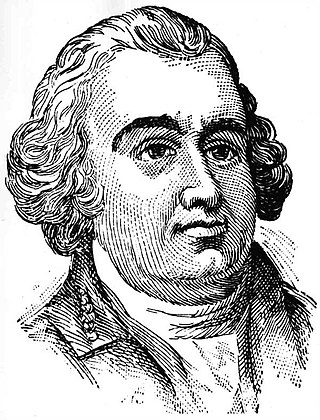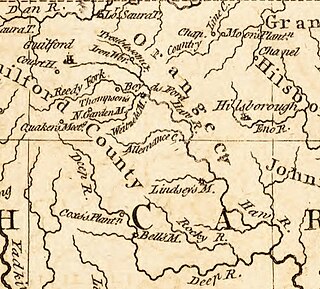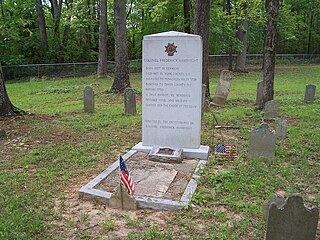
Bladen County is a county located in the U.S. state of North Carolina. As of the 2020 census, the population was 29,606. Its county seat is Elizabethtown. The county was created in 1734 as Bladen Precinct and gained county status in 1739.

Thomas Burke was an Irish physician, lawyer, and statesman who lived in Hillsborough, North Carolina. He represented North Carolina as a delegate to the Continental Congress and was the third governor of the state. He was the first Catholic governor of North Carolina.

Jones Lake State Park is a North Carolina state park in Bladen County, North Carolina in the United States near Elizabethtown. It covers 2,208-acre (8.94 km2), including the Carolina bay lakes of Jones Lake and Salters Lake. Jones Lake State Park is north of Elizabethtown on North Carolina Highway 242 in North Carolina's Coastal Plain region. The park offers year-round recreation, including fishing, swimming, boating, hiking, picnicking and environmental and historical education programs.

The Battle of Kings Mountain was a military engagement between Patriot and Loyalist militias in South Carolina during the Southern Campaign of the American Revolutionary War, resulting in a decisive victory for the Patriots. The battle took place on October 7, 1780, 9 miles (14 km) south of the present-day town of Kings Mountain, North Carolina. In what is now rural Cherokee County, South Carolina, the Patriot militia defeated the Loyalist militia commanded by British Major Patrick Ferguson of the 71st Foot. The battle has been described as "the war's largest all-American fight".

Patrick Ferguson was a Scottish officer in the British Army, an early advocate of light infantry and the designer of the Ferguson rifle. He is best known for his service in the 1780 military campaign of Charles Cornwallis during the American Revolutionary War in the Carolinas, in which he played a great effort in recruiting American Loyalists to serve in his militia against the Patriots.

The Battle of Moore's Creek Bridge was a minor conflict of the American Revolutionary War fought near Wilmington, North Carolina, on February 27, 1776. The victory of the North Carolina Provincial Congress' militia force over British governor Josiah Martin's and Tristan Worsley's reinforcements at Moore's was a turning point in the war; American independence was declared less than five months later.

David Fanning was a Loyalist leader in the American Revolutionary War in North and South Carolina. Fanning participated in approximately 36 minor engagements and skirmishes, and in 1781, captured the Governor of North Carolina, Thomas Burke, from the temporary capital at Hillsborough. Additionally, Fanning was captured by Patriot forces 14 times throughout the war, each time escaping or receiving a pardon. After the British defeat in the war, Fanning fled to Canada, where he was elected to the Legislative Assembly of New Brunswick from 1791 to 1801 representing Kings County. After being convicted of rape in 1801, Fanning was expelled from New Brunswick, and settled in Nova Scotia, where he lived the remainder of his life.

The Battle of Lindley's Mill took place in Orange County, North Carolina, on September 13, 1781, during the American Revolutionary War. The battle took its name from a mill that sat at the site of the battle on Cane Creek, which sat along a road connecting what was then the temporary state capital, Hillsborough, with Wilmington, North Carolina.

The Battle of Musgrove Mill, August 19, 1780, occurred near a ford of the Enoree River, near the present-day border between Spartanburg, Laurens and Union Counties in South Carolina. During the course of the battle, 200 Patriot militiamen defeated a combined force of approximately 300 Loyalist militiamen and 200 provincial regulars.
33°28'12.00"N, 81°58'30.00"W
Huck's Defeat or the Battle of Williamson's Plantation was an engagement of the American Revolutionary War that occurred in present York County, South Carolina on July 12, 1780, and was one of the first battles of the southern campaign to be won by Patriot militia.

Frederick Hambright was a military officer who fought in both the local militia and in the North Carolina Line of the Continental Army during the Revolutionary War. He is best known for his participation in the Battle of Kings Mountain in 1780. Serving as a statesman early in the Revolution, Hambright joined the war in 1777, ranked a lieutenant colonel in a local militia. His early actions were limited to occasional checks on Loyalist groups. This changed in 1780 with Hambright's important role at the Battle of Kings Mountain, which occurred near his lands in the newly formed Lincoln County, North Carolina. Hambright was commended for his bravery during the battle, though suffering a wound which forced him to permanently resign from military service.
The Battle of Wahab's Plantation was a surprise attack on a Loyalist camp, which included elements of the British Legion commanded by Banastre Tarleton, by Patriot militia under the command of William R. Davie on September 21, 1780. The owner of the plantation was militia Captain James A. Walkup who served as a guide for Davie prior to the attack. Confusion has arisen over the spelling of the name Wahab as there are many spellings of the surname including, Walkup/Wahab/Wauchope/Waughup. The Loyalists were camped on the west side of the Catawba River while General Charles Cornwallis' army had camped on the east side. Davie opportunistically decided to attack the Loyalist camp, and succeeded in driving them back in complete surprise and with heavy casualties. He retreated before the British regulars arrived. The latter, as was customary, burned down Captain Walkup's plantation.
William "Bloody Bill" Cunningham (1756–1787) was an American loyalist infamous for perpetrating a series of bloody massacres in South Carolina's backcountry in the fall of 1781 as commander of a Tory militia regiment in the Revolutionary War. Though his family were loyal to the British crown, Cunningham initially enlisted in the Continental Army as part of the State of South Carolina's 3rd regiment in 1775. His tenure in the rebel army was an unhappy one and Cunningham changed sides to fight for the British in 1778. He earned the nickname "Bloody Bill" for the violent, ruthless nature of his raids on rebels and patriot civilians.

Colonists who supported the British cause in the American Revolution were Loyalists, often called Tories, or, occasionally, Royalists or King's Men. For a detailed analysis of the psychology and social origins of the Loyalists, see Loyalist.
John Butler was a military officer in the Hillsborough District Brigade of the North Carolina militia during the American Revolutionary War from 1775 to 1784, and served as its commanding general between 1779 and the end of the conflict. He was a member of the North Carolina House of Commons for several terms simultaneously with his military service. Butler commanded soldiers in several major engagements throughout North and South Carolina, but is perhaps best remembered for his role in the Patriot defeat at the Battle of Lindley's Mill. Butler died shortly after the end of the war, and his career as a military commander has received mixed reviews by historians.
Francis Locke Sr. (1722–1796) was a plantation owner, businessman, politician, and a participant in the American War of Independence, where he led the American Patriots to the decisive victory at Ramseur's Mill, which turned the tide of the American War for Independence in the south.
The Wilmington District Brigade was an administrative division of the North Carolina militia during the American Revolutionary War (1776–1783). This unit was established by the North Carolina Provincial Congress on May 4, 1776, and disbanded at the end of the war.
Thomas Wade (1720–1786) was a merchant, commander of the Anson County Regiment of North Carolina militia during the American Revolution, and senator from Anson County in the North Carolina Provincial Congress and General Assembly. Wadesboro, North Carolina was named for him.
The Battle of Raft Swamp was fought near Red Springs, North Carolina in Robeson County, on October 15, 1781 during the American War of Independence. Raft Swamp was well known for being a refuge for Loyalists during the American Revolution. On October 15, 1781, in the course of Gen. Griffith Rutherford's expedition against Wilmington, the Patriot cavalry vanguard commanded by Maj. Joseph Graham briefly engaged with some mounted Loyalists of Col. Hector "One-Eyed Hector" McNeill on Rockfish Creek. Major Graham's calvary charged and broke the Loyalist cavalry and led to fierce combat on the narrow causeway, as well as another clash on a second causeway. A series of charges and confused engagements resulted in the Loyalist forces scattering when darkness brought the action to a conclusion with the Patriots occupying the area.Today, a state historic marker entitled with the name of the swamp denotes the site of the engagement. It reads as follows: "After the Tory victory at McPhaul's Mill, the Whigs routed the Tories near here on Oct. 15, 1781 and broke their resistance in the area."









